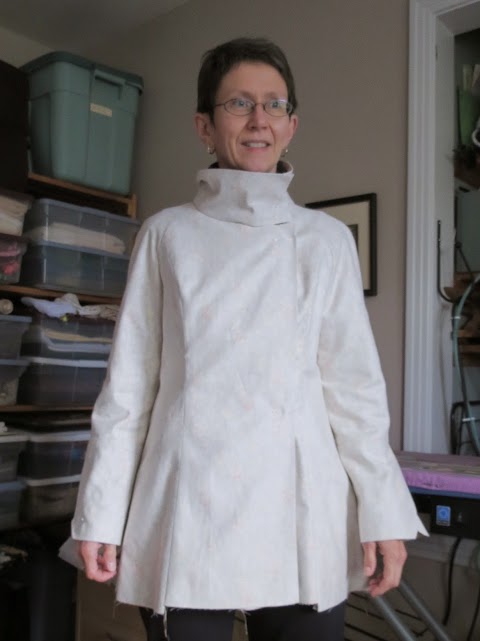It's a lot of fun.
I made two pairs of socks. Yes it is possible to make socks in the round on a double bed knitting machine. And it's so fast! I'm cranking them out (4 so far) at about 2 hours per sock. And I'm a raw beginner.
I made a colourful pair for myself.
And I made a sober grey tweedy pair for my husband. He's already investigating the rest of the sock yarn in stash for his next pair...
In the above photo, the sock isn't quite finished. Because you have to knit the ribbing on both beds at once, there is a seam to sew up at CB. And the final stitches at the toe have to be finished with Kitchener stitch. So much easier on a machine knitted sock than doing it from stitches on needles! At left you can see there is a little light blue - this is scrap yarn knitted in a narrow tube to keep the last live stitches safe until they can be grafted together by hand. I just follow the path of the light blue yarn and snug up my stitches until they are truly invisible. Magic!
.jpg) So then I decided I'd make a sweater for myself. I chose a pattern designed to be knitted by hand, top down, seamlessly (Boxy and Buttony by Joji Locatelli).
So then I decided I'd make a sweater for myself. I chose a pattern designed to be knitted by hand, top down, seamlessly (Boxy and Buttony by Joji Locatelli). I carefully read the pattern and made a schematic so I would understand the structure. And then I knitted a swatch and mentally rehearsed how I would knit it by machine, bottom up, with seams. Because that's the way the The Sewing Lawyer rolls.
Behold:
It makes perfect sense, no?
My swatch revealed that I had to knit on the loosest tension possible on my machine, and also that at that tension and over 60 stitches, the yarn colours pooled vertically.
 |
| Pooling at SS8.0 but not at 7.0 or 6.0 |
 Well I didn't. Cast on (three times before being satisfied, not noticing that I'd dropped a stitch) at about 10PM yesterday, and zip-zip-zip knitted the back up to where I had to increase for the sleeves before bedtime.
Well I didn't. Cast on (three times before being satisfied, not noticing that I'd dropped a stitch) at about 10PM yesterday, and zip-zip-zip knitted the back up to where I had to increase for the sleeves before bedtime. Didn't I say that it was fast? See the hole at lower left...
I decided I could latch the missing stitch up by hand and fix it invisibly so I continued.
And then I ran into problems at the shoulder (which involves short rows and a band of ribbing). So I decided to unravel the whole shebang and start over.
I learned a lot.
- At a loose tension, you really do need weights. Without them (as I discovered at the shoulder) the stitches just leap off the needles.
- When doing short rows, ditto. The most precarious stitches were the ones at the high side where the length was building up relative to the front neck stitches that were holding.
- Ribbing should be knitted tighter than stockinette. I knew this at the hem (used SS 7.5 instead of 8.0) but forgot by the shoulder.
- Increasing six stitches at the end of a row is possible, using a crocheted chain... AND WEIGHTS!
And if the yarn pools over 60 stitches, it will pool similarly over 180. Sigh.
Here, for posterity, is the back which will be unravelled shortly - hopefully before the yarn is too kinky and needs steaming or something.
The actual colour is a lot darker (more maroon than bright red).

.jpg)



0 Comments